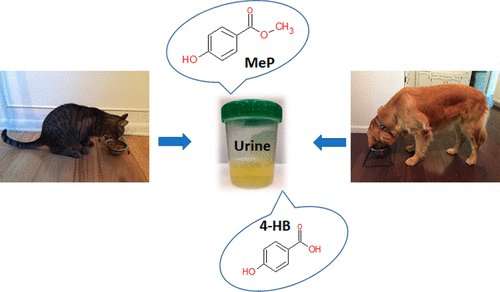How cats and dogs are consuming and processing parabens

Many households can claim at least one four-legged friend as part of the family. But pets that primarily stay indoors can have increased rates of diseases, such as diabetes, kidney diseases and hypothyroidism compared with those that stay exclusively outside. Some scientists propose that chemical substances in the home could contribute to these illnesses. One group has examined how pets could be exposed to parabens, as reported in ACS' journal Environmental Science & Technology.
Parabens are preservatives commonly found in cosmetic and pharmaceutical products, and their use in human food products and dog and cat food is regulated by the U.S. Food & Drug Administration. The substances also have been shown to be endocrine-disrupting compounds (EDCs). Research has shown EDCs potentially interfere with hormones and have harmful effects on developmental, reproductive and neurological systems. Previous studies have examined the presence of other EDCs, such as heavy metals and bisphenol A, in pet food, but very little is known about parabens in this context. So, Kurunthachalam Kannan and colleagues wanted to examine the exposure of dogs and cats to parabens in commercially available pet food and analyze the substances in the animals' urine.
The team examined 58 variations of dog and cat food, as well as 60 urine samples from animals. The paraben called methyl paraben and the metabolite called 4-hydroxybenzoic acid (4-HB) were the most abundant chemicals detected in pet food and urine. The researchers found that dry food contained higher levels of parabens and their metabolites than wet food. In addition, the researchers report, cat food had higher paraben concentrations than dog food. After the urine analysis, the group calculated the cumulative exposure intake for the dogs and cats. By comparing the calculations, the team concluded that dogs are exposed to other sources of parabens, besides food, whereas cats' exposure is mainly from their diet. The group also notes that to their knowledge, this is the first time the occurrence of these substances has been reported in pet food and urine in the U.S.
More information: Rajendiran Karthikraj et al. Parabens and Their Metabolites in Pet Food and Urine from New York State, United States, Environmental Science & Technology (2018). DOI: 10.1021/acs.est.7b05981
Abstract
The exposure of pets, such as dogs and cats, to a wide range of chemicals present in the indoor environment and the concomitant increase in noninfectious diseases in these companion animals are a concern. Nevertheless, little is known about the sources and pathways of exposure to chemicals in pets. In this study, we determined the concentrations of parabens in commercially available cat and dog foods as well as in urine samples from these pets collected from the Albany area of the state of New York in the United States. Parabens, especially methyl paraben (MeP), and their metabolites were found in all pet food and urine samples. The mean concentrations of total parabens (i.e., sum of parabens and their metabolites) in dog (n = 23) and cat (n = 35) food were 1350 and 1550 ng/g fresh wt, respectively. Dry food contained higher concentrations of parabens and their metabolites than did wet food, and cat food contained higher concentrations of target chemicals than did dog food. The mean concentrations of total parabens found in dog (n = 30) and cat (n = 30) urine were 7230 and 1040 ng/mL, respectively. In both pet food and urine, MeP (among parabens) and 4-hydroxy benzoic acid (4-HB) (among metabolites) were the dominant compounds. The metabolites of parabens accounted for ∼99% (∼99.1% in food and ∼98.9% in urine) of the total concentrations in both food and urine. The profiles of parabens and their metabolites in the urine of dogs and cats varied. In addition to diet, other sources of paraben exposures were found for dogs, whereas, for cats, the majority of exposures was identified as related to diet.
Journal information: Environmental Science & Technology
Provided by American Chemical Society

















